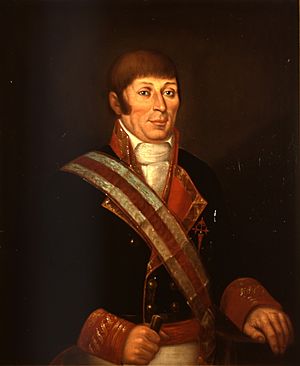Francisco Antonio Mourelle facts for kids
Francisco Antonio Mourelle de la Rúa (born July 17, 1750 – died May 24, 1820) was a brave Spanish naval officer. He was also a famous explorer who sailed for Spain. He was born in 1750 in a place called San Adrián de Corme, in Galicia, Spain.
Contents
Early Life and First Voyage
Before his big adventures, Mourelle worked for the Spanish navy. He served in places like the Guyanas, Trinidad, and the Antilles. In 1774, he moved to San Blas, Mexico. This was a Spanish naval base on the Pacific Ocean.
The 1775 Expedition
In 1775, Mourelle joined an important expedition. He was the pilot on a ship called the Sonora. The expedition was led by Bruno de Heceta and Juan Francisco de la Bodega y Quadra.
Exploring the Coast
On July 29, the Sonora got separated from the main ship, the Santiago. This happened near 49 degrees north latitude. Heceta's ship went back south. But Quadra and Mourelle kept sailing north. They reached as far as 58 degrees 30 minutes north latitude.
Discoveries and Return
They found a bay and anchored there. It was called Bucareli Bay. After that, they sailed south. They arrived at Monterey, California, on October 7. Finally, they reached San Blas on November 20, 1775.
Mourelle kept a detailed journal of his travels. This journal was secretly taken to London. There, it was translated and published. Even Captain James Cook, another famous explorer, used Mourelle's information. He used it during his own trips in the Pacific Northwest.
The 1779 Voyage
Mourelle went on another big trip in 1779. He was again the pilot for Quadra. He was also the second-in-command of a ship called the Favorita. This expedition was led by Ignacio de Arteaga.
Journey to Alaska
The ships left San Blas on February 11, 1779. They sailed north and reached 61 degrees north latitude. They also explored Hinchinbrook Island. This island is at the top of the Gulf of Alaska.
Sailing South
From Hinchinbrook Island, they sailed southwest. They explored along the Kenai Peninsula. The ships returned to San Blas on November 21, 1779.
Later Adventures
While working at San Blas, Mourelle traveled a lot across the Pacific Ocean. He explored many different places.
Pacific Explorations
From 1780 to 1781, he sailed on a ship called the La Princessa. He tried to find a southern route from the Philippines to Mexico. During this trip, he mapped many islands. These included 29 islands in the Hermit Islands, Ninigo Islands, and Tench Island in New Guinea. He also found Ontong Java, which is near the Solomon Islands.
He visited Tonga and sailed through the Ellice Islands. These islands are known today as Tuvalu. Experts Keith S. Chambers and Doug Munro (1980) believe Mourelle named Niutao island on May 5, 1781. This helped solve a mystery Europeans called The Mystery of Gran Cocal.
Return and Other Travels
Because of strong winds, he had to return a different way. He went via Guam and took the northern route across the Pacific to Mexico. Mourelle also knew a lot about the Philippines and Canton, China.
Mourelle was supposed to command a ship called the Mexicana in 1792. This trip was to explore the Strait of Georgia. But another officer, Cayetano Valdés, was put in charge instead. Dionisio Alcalá Galiano commanded the Sutil, which was the Mexicana's twin ship.
Life in Spain and Legacy
In 1793, Mourelle moved to Spain. He was promoted to frigate captain that same year. He became a ship's captain in 1806 and a commodore in 1811. In 1818, he commanded a group of ships for a mission that didn't happen.
Mourelle passed away on May 24, 1820. He was 69 years old.
His Name Lives On
Today, Maurelle Island in Canada is named after him. This island is part of the Discovery Islands on the South Coast of British Columbia.
See also
 In Spanish: Francisco Mourelle para niños
In Spanish: Francisco Mourelle para niños


